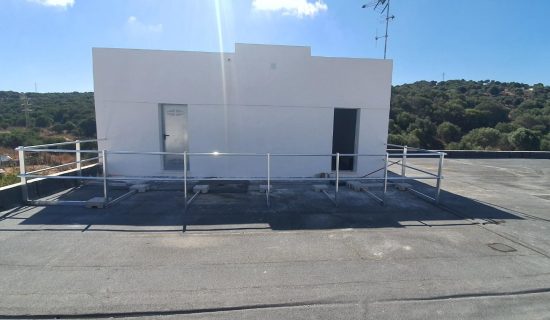Contenidos
- Introduction to the Standard UNE-EN ISO 14122-3
- General Requirements for Handrails and Guardrails
- Key Guardrail Components
- Installation of Handrails in Different Environments
- Why trust Safeway360 for Guardrail Installation?
- Safety Assurance Test Methods
- Practical Advice and Best Practices
- Frequently Asked Questions on the UNE-EN ISO 14122-3 Standard
Introduction to the Standard UNE-EN ISO 14122-3
Regulatory handrails are not only important to protect your workers, but they are also necessary to guarantee the integrity and safety of your company.
In this article you will find what you need to know about the UNE-EN ISO 14122-3 standard for the installation of fixed handrails.
Ready to learn how to implement this standard in your project? Read on.
What is the UNE-EN ISO 14122-3 Standard?
UNE-EN ISO 14122-3 Safety of machines. Permanent means of access to machinery. Part 3: Ladders, step ladders and guard rails (ISO 14122-3:2016), is a standard that regulates the design, construction and installation of guardrails for access to machinery and scaffolding. The main objective is to establish clear standards to minimize fall hazards and ensure the safety of the industrial environment.
Why is this regulation important?
If you comply with the regulations in your industrial plant, you ensure that:
- You protect your company’s human capital.
- You optimize the functionality of your industrial infrastructure.
- You avoid financial penalties for non-compliance with the law.
Scope of Application: Machine and Access Safety
The UNE-EN ISO 14122-3 standard applies to machines, walkways, platforms, fixed and mobile ladders and other industrial accessibility. In this case, handrails are an example of these elements, since they guarantee safety in jobs where there is a risk of falling.
Application areas range from small industry to multinationals.
It is applied wherever safe access is required to prevent hazards during maintenance, inspection or repair work.
Main updates of the 2016 edition
In 2016, some updates were introduced to adapt to new safety and efficiency standards, of which we highlight:
- Fall protection: The requirements for handrails and side protection systems have been improved. Handrails are supplied in a standard design with a minimum height of 1,100 mm and the maximum distance between protection elements is specified at 500 mm.
- Anti-slip: New recommendations for materials and finishes for stairs and work surfaces, with the purpose of guaranteeing slip resistance.
- Structural stability and materials: The standard reinforces the requirements related to the structure and materials used.
- Load tests: Platforms and ladders must withstand a static load of at least 1.5 kN/m², with clear guidance on test conditions.
- Clear labeling: requirements for labels or plates specifying the load capacity and use of each component.
This standard complies with European and international standards, such as ISO 14122, ensuring consistency of approach and machine safety in all countries.
In compliance with regulations, our safety handrails conform to the highest safety standards. They comply with UNE-EN 13374 and UNE-EN ISO 14122. Consult our catalog and contact us.
General Requirements for Handrails and Guardrails
Safe Design and Construction
It is very important that the design of guardrails meets certain requirements to ensure their function as a protective element. The rules require that guardrails must be able to withstand specific loads and integrate effectively into their surroundings. This involves taking into account different aspects such as altitude, access and visibility of the guardrail.
Minimum Heights and Standard Dimensions
The regulations establish minimum heights for guardrails, which are generally at least 1,100 mm for platforms and walkways.
These dimensions must ensure that a person cannot fall when sliding over them. The space between cross members must not exceed 500 mm.
Structural strength and nominal load
Guardrails must be designed to be able to withstand specific loads, which will differ according to the type of installation. These elements must withstand horizontal and vertical forces without affecting their integrity, as they are safety elements that must provide effective protection.
Key Guardrail Components
Posts, Handrails and Toeboards: Technical Characteristics
As for the railing components, they should be made of sturdy and durable materials. The posts will support the weight and tension, while the handrail will provide a non-slip and comfortable surface. The toe boards will prevent objects from falling. The materials recommended by standards are mainly galvanized steel, aluminum or reinforced PVC.
Installation of Handrails in Different Environments
Guardrails are essential in many applications, such as work platforms, stairs and walkways. Each environment has different needs that must be considered to protect the user.
Inclined or vertical access requires a specific design. The height and design of the guardrail may vary, but it must still comply with guardrail standards to minimize the risk of falls.
In high-risk areas, such as factories or chemical plants, guardrails must withstand extreme conditions and provide greater protection for the user.
Why trust Safeway360 for Guardrail Installation?
At Safeway360 we have extensive experience in the installation of fall protection systems, such as guardrails.
We ensure that each assembly complies with the highest quality standards and regulations such as UNE-EN ISO 14122, to guarantee maximum safety in your installations.
We offer you the professionalism of a team of experts who work every day to provide the best solution to your preventive needs. Contact us without obligation.
Safety Assurance Test Methods
This is a key process that ensures that fixed guardrails comply with regulations, and where the strength of the structure is evaluated, as well as the stability and durability of the materials used in their manufacture.
Static and dynamic load tests are performed to verify whether the handrails can withstand the forces they may be subjected to in a real working environment.
Safety Marking and Mandatory Documentation
All handrails that comply with the handrail standard must bear a visible marking indicating their conformity to UNE-EN ISO 14122-3. This marking shall be accompanied by the mandatory documentation indicating the technical specifications and the results of the tests passed.
User and maintenance manuals can be added, which will help users comply with best practices for occupational safety.
Practical Advice and Best Practices
Following the guardrail regulations brings significant benefits to your company. In addition to improving the safety of your workers, it minimizes the risk of workplace accidents and reduces the cost of workers’ compensation and sick leave.
If you prioritize safety in your environment, you improve the company’s image and avoid regulatory sanctions.
When choosing a guardrail you should consider the installation environment, height, load capacity and relevant regulations.
Improper railing installation can have serious consequences, so it is important to follow the manufacturer’s guidelines, analyze the point of installation and use quality materials.
To avoid these mistakes, trust Safeway360, we will not only advise you, but also provide you with an installation and after sales service.
Frequently Asked Questions on the UNE-EN ISO 14122-3 Standard
Is this Standard Mandatory for Industrial Installations?
In Spain, the UNE-EN ISO 14122-3 standard is not mandatory per se, but it is worth relating it to the Spanish laws that do. This is the relationship of this standard with the Machinery Directive 2006/42/EC: this European directive is part of Spanish legislation through the constituent regulation, Royal Decree 1644/2008, which establishes the essential health and safety requirements for machinery at national level.
In other words, a company that manufactures or uses guardrails is not obliged to use the UNE-EN ISO 14122-3 standard, but if an accident occurs and it is investigated whether the guardrail complied with the safety requirements, the company will have to prove it. Although it is not directly mandatory, compliance with this regulation ensures safety in your company.
What are the Best Practices for Maintenance?
Best practices include periodic inspections, cleaning of the elements to prevent corrosion, for example, and immediate replacement if there is a damaged component. All of this should be documented.
Don’t leave the protection of your equipment to chance! Together we will ensure a safer and more efficient work environment for everyone. Contact us now.






